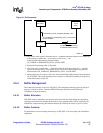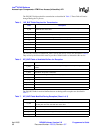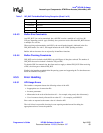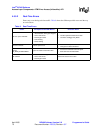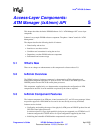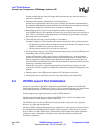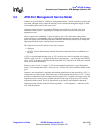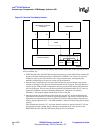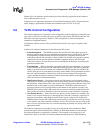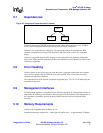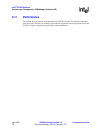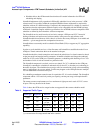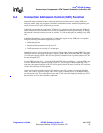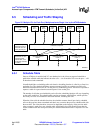
Intel
®
IXP400 Software
Access-Layer Components: ATM Manager (IxAtmm) API
Programmer’s Guide IXP400 Software Version 2.0 April 2005
Document Number: 252539, Revision: 007 75
Further calls to IxAtmDAcc must be made by the client following registration with IxAtmm to
fully enable data traffic on a VC.
IxAtmm does not support the registration of Virtual Path Connections (VPCs). Registration and
traffic shaping is performed by IxAtmm and IxAtmSch on the VC/VCC level only.
5.6 Tx/Rx Control Configuration
The IxAtmm application is responsible for the configuration of the mechanism by which the lower-
layer services will drive transmit and receive of traffic to and from the IXP4XX product line and
IXC1100 control plane processors’ hardware. This configuration is achieved through the
IxAtmdAcc component interface.
Configuration of these services will be performed when the first active port is registered with
IxAtmm.
IxAtmm will configure IxAtmdAcc for the following traffic events:
• Transmit Required — The IXP4XX product line and IXC1100 control plane processors’
hardware requires more cells to be scheduled for transmission on a particular port. IxAtmm
will implement a callback function that will be registered as a target for the low-queue
notification callback with IxAtmdAcc. When invoked, this function will generate a transmit
schedule table for the port through the IxAtmSch component and pass this table to the
IxAtmdAcc interface to cause more cells to be transmitted to the hardware, according to the
generated schedule table.
• Transmit Done — When all data from a particular buffer has been transmitted, it is necessary
for the IXP4XX product line and IXC1100 control plane processors’ hardware to return the
buffer to the relevant client. IxAtmm will configure the IXP4XX product line and IXC1100
control plane processors such that the processing of these buffers will be performed whenever
there are a specific number of buffers ready to be processed. IxAtmm will configure the
system such that the default IxAtmdAcc interface returns these buffers to the appropriate
clients and are then invoked automatically.
• High-Priority Receive — Data received on the any high-priority receive channel (such as
voice traffic) is required to be supplied to the client in a timely manner. IxAtmm will configure
the IxAtmdAcc component to process the receipt of data on high-priority channels using a low
threshold value on the number of received data packets. The default IxAtmdAcc receive
processing interface will be invoked whenever the number of data packets received by the
IXP4XX product line and IXC1100 control plane processors reaches the supplied threshold.
These packets will then be dispatched to the relevant clients by the IxAtmdAcc component.
• Low-Priority Receive — Data received on low-priority receive channels (for example, data
traffic) is not as urgent for delivery as the high-priority data and is, therefore, expected to be
tolerant of some latency when being processed by the system. IxAtmm will configure the
IXP4XX product line and IXC1100 control plane processors such that the receive processing
of low-priority data will be handled according to a timer. This will cause the processing of this
data to occur at regular time intervals, each time returning all pending low-priority data to the
appropriate clients.
The IxAtmm component is responsible only for the configuration of this mechanism. Where
possible the targets of threshold and timer callbacks are the default interfaces for the relevant
processing mechanism, as supplied by IxAtmdAcc. The exception is the processing of cell
transmission, which is driven by an IxAtmm callback interface that passes ATM scheduling



